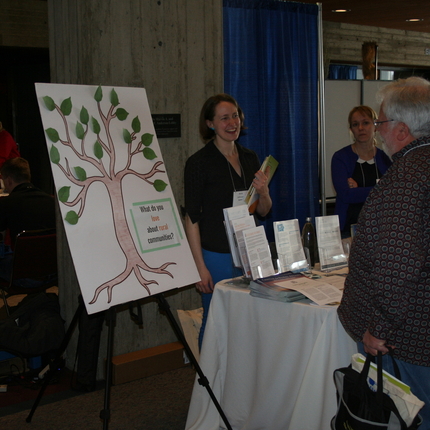By Lacie Dotterweich, former staff member
What do you love about rural communities? We asked attendees of the Practical Farmers of Iowa’s annual conference last month, when they stopped by our Center for Rural Affairs booth.
“Neighbors invest their time, talents, and equipment to improve my farm, and vice versa.”
“The ability/willingness of the community to come together in times of need.”
“Connections and supporting small businesses.”
“Close-knit community of friends.”
“Farmer wave.”
The responses were heartwarming and drove home the conference theme, “Revival of Rural Communities.” People want to see their homes repopulated, their businesses thrive, and young people returning to start families and grow the community even more.
One way to boost a revival in your rural community is to get involved. In the session, “Better Food, Farm, and Conservation Policies Thorough Involvement,” Anna Johnson, Center for Rural Affairs policy associate, spoke about policy engagement alongside Dr. Kamyar Enshayan, University of Northern Iowa’s Center for Energy & Environmental Education.
In the session, attendees shared thoughts and concerns for their rural communities, ranging from rural economic opportunity to clean water, habitat for pollinators, and food access. Many shared concerns about soil health, local foods, rural cultural vibrancy, and land access for beginning farmers.
Anna encouraged conference goers to engage with their legislators on these issues. One avenue she suggested was to share support for farm bill conservation programs, such as the Conservation Stewardship Program and the Environmental Quality Incentive Program. These programs allow farmers to continue production while implementing practices that help build soil health and maintain water quality.
Dr. Enshayan followed up with attendees about other ways to get involved, including serving on a Farm Service Agency committee, extension board, or Soil and Water Conservation District Board.
Farmers also shared their stories during the conference. Through the Conservation Stewardship Program, one farmer had the opportunity to install pollinator habitats. Another was thankful for networking at beginner farmer programs, as he had just moved to Iowa and didn’t have many connections.
Talk of conservation continued with Dr. Alejandro Plastina, of Iowa State University, who gave an evaluation on the economics of cover crops in the Midwest. He spoke of limited science-based information, and talked about the Agricultural Production System Simulator that will reduce the uncertainty of planting these crops. With the simulator, Plastina hopes more acres of cover crops will be planted.
The focus then turned to soil health through carbon-building. Keith Berns, co-owner and operator of Green Cover Seed, in Bladen, Nebraska, gave a talk on “Carbonomics,” comparing soil health to economics. In this framework, soil carbon can be considered similar to money and capital. Some activities, such as intensive tillage will “spend” soil carbon, while others, such as planting cover crops, will build it. With a strong reserve of carbon, soils are more resilient to drought and flooding, compared to strong savings and assets helping businesses through times of low crop prices.
The Practical Farmers of Iowa conference is just one opportunity for people to come together and talk about the value of rural communities. These events are critical for the growth and revival of rural spaces.
Feature photo: Center for Rural Affairs Policy Associates Anna Johnson and Katie Rock ask, "What do you love about rural communities," at the Practical Farmers of Iowa annual conference last month. | Photo by Lacie Dotterweich





